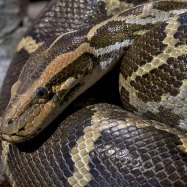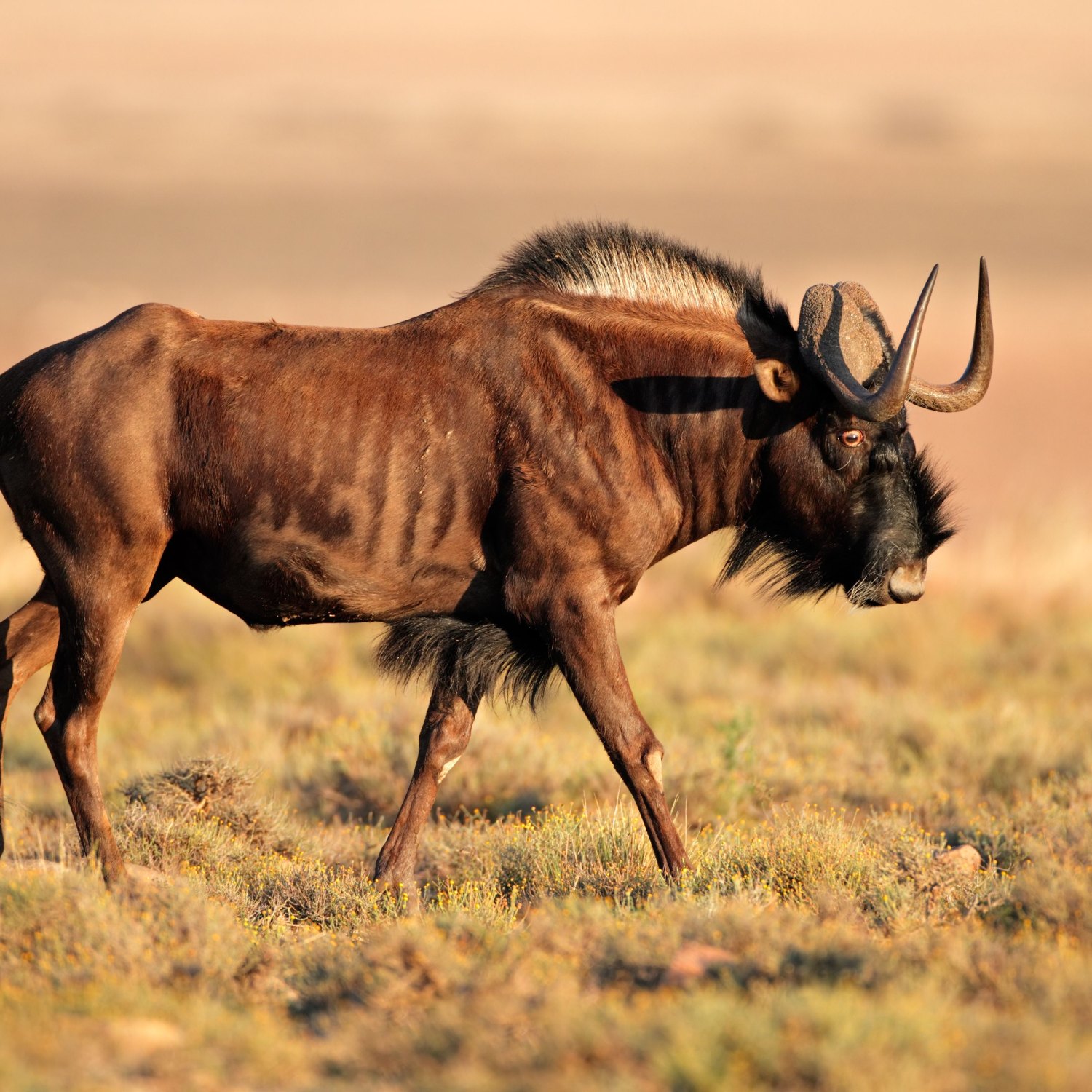
Wildebeest
1.4 to 2.2 meters (4.5 to 7.2 feet)
The wildebeest, found in Tanzania, Kenya, South Africa, Botswana, Namibia, and Zimbabwe, is a member of the Bovidae family. These large, muscular animals can reach lengths of 1.4 to 2.2 meters. With their distinct broad shoulders, they are an iconic sight on the African savannah. #wildebeest #africananimals #bovidae #safari #wildlife
Animal Details Summary:
Common Name: Wildebeest
Kingdom: Animalia
Habitat: Savannahs, grasslands, and floodplains
The Magnificent Wildebeest: A Marvel of the African Savanna
As you journey through the vast savannas of Africa, it is hard to miss the sight of a majestic animal - the wildebeest. With its large, muscular body and striking black mane, this animal is a true marvel of the African wilderness.Scientifically known as Connochaetes taurinus, the wildebeest is a member of the Artiodactyla order, belonging to the family Bovidae. This unique animal is commonly known as the wildebeest and is sometimes referred to as the "gnu" - a name derived from the Dutch word "gnoe Wildebeest."
Wildebeests are found in Eastern and Southern Africa, making their homes in countries such as Tanzania, Kenya, South Africa, Botswana, Namibia, and Zimbabwe. They thrive in a variety of habitats, including savannahs, grasslands, and floodplains. These animals are known for their immense migratory movements, traveling long distances in search of water and greener pastures.
This fascinating animal is a herbivore, meaning that its diet consists entirely of plants. The wildebeest plays a vital role in the ecosystem as it helps to maintain a balance between vegetation and grazing pressure. They are known to feed on a variety of grasses, herbs, and shrubs, making them vital components of the African savanna.
Wildebeests have a unique and fascinating body structure. They are large animals with broad shoulders and a muscular build, allowing them to undertake long and arduous migrations. The average length of a wildebeest ranges from 1 Wild Boar.4 to 2.2 meters (4.5 to 7.2 feet), and they can weigh up to 270 kilograms (595 pounds). They have a dark brown to gray coat, with a black mane and tail that adds to their distinct appearance.
These animals are incredibly social creatures, forming herds of up to a few thousand individuals. Within these herds, they exhibit a complex social structure, with dominant males leading the group and females taking on the role of nurturers. The wildebeest's social bonds are integral to their survival, especially during the annual migration where they face many challenges.
One of the most intriguing aspects of the wildebeest is their annual migration. Every year, over 1.5 million of these animals travel in a circular pattern across Eastern and Southern Africa in search of resources. The migration starts in Tanzania's Serengeti National Park and ends in Kenya's Maasai Mara National Reserve. This migration is considered the largest land animal migration on the planet, with wildebeests covering over 800 kilometers (500 miles) in search of food and water.
The journey of the wildebeest is one of the most spectacular sights in the world. As they traverse through the savannas, they face many obstacles, including crossing treacherous rivers, avoiding predators, and handling harsh weather conditions. The most well-known and dramatic part of their journey is when they cross the crocodile-infested Mara River in Kenya. This event draws hundreds of tourists each year, eager to witness this natural wonder.
One of the most remarkable aspects of the wildebeest migration is the synchronization among the herd. They coordinate their movements, and their migrations are often compared to an elaborate military operation. Researchers have been baffled by the level of coordination and communication among these animals, with no clear explanation for this phenomenon.
Apart from being an integral part of the ecosystem, the wildebeest migration provides a significant economic boost to the countries where it occurs. It draws in tourists from all over the world, generating revenue for local communities and contributing to conservation efforts. This serves as an excellent example of how wildlife and tourism can coexist in a sustainable manner.
While the wildebeest is considered one of the most iconic animals of the African savanna, it is also facing various threats. Habitat loss and fragmentation, poaching, and human-wildlife conflict are significant concerns for the survival of this species. Climate change also poses a threat as it affects the availability of water and vegetation, crucial for the wildebeest's survival.
To address these issues, several conservation efforts are in place to protect and preserve wildebeest populations. Working closely with local communities, wildlife organizations are educating people on sustainable land use practices and the value of wildebeests to their ecosystem. Strict laws and regulations have been put in place to curb poaching, and efforts are being made to establish protected areas for the wildebeests.
In conclusion, the wildebeest is a magnificent animal that captures the imagination of all who encounter it. Its annual migration, unique social structure, and vital role in the ecosystem make it a species worth protecting. As we continue to strive towards coexistence with these beautiful creatures, it is vital to remember the importance of preserving their habitats and ensuring their survival for generations to come. Next time you encounter a wildebeest in the African savanna, take a moment to appreciate its beauty and understand the value it holds in the delicate balance of its habitat.

Wildebeest
Animal Details Wildebeest - Scientific Name: Connochaetes taurinus
- Category: Animals W
- Scientific Name: Connochaetes taurinus
- Common Name: Wildebeest
- Kingdom: Animalia
- Phylum: Chordata
- Class: Mammalia
- Order: Artiodactyla
- Family: Bovidae
- Habitat: Savannahs, grasslands, and floodplains
- Feeding Method: Herbivorous
- Geographical Distribution: Eastern and Southern Africa
- Country of Origin: Africa
- Location: Tanzania, Kenya, South Africa, Botswana, Namibia, Zimbabwe
- Animal Coloration: Dark brown to gray with a black mane and tail
- Body Shape: Large, broad-shouldered, and muscular
- Length: 1.4 to 2.2 meters (4.5 to 7.2 feet)
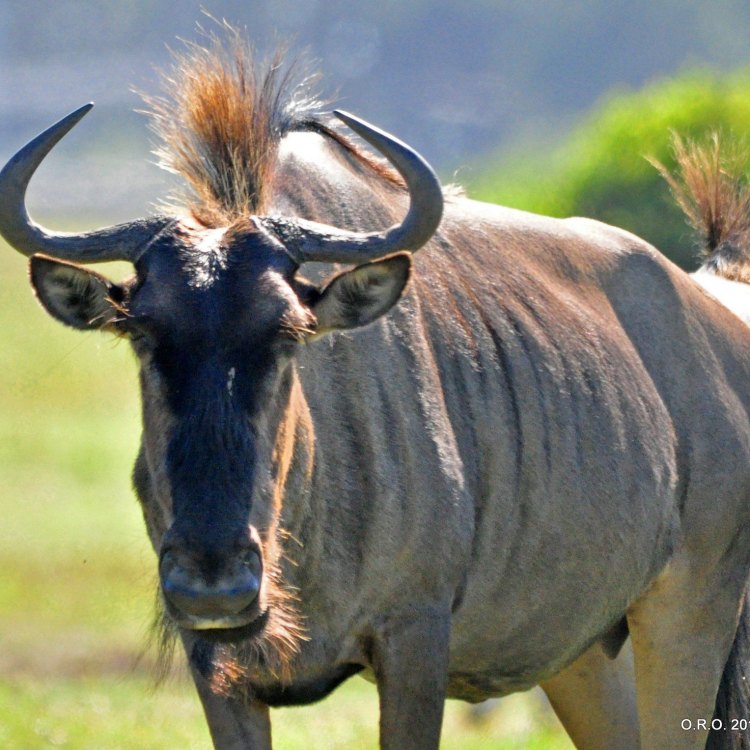
Wildebeest
- Adult Size: Height at shoulder: 1.3 to 1.5 meters (4.3 to 4.9 feet)
- Average Lifespan: 20 years in the wild
- Reproduction: Sexual
- Reproductive Behavior: Mating occurs during the rainy season
- Sound or Call: Loud grunts and snorts
- Migration Pattern: Highly migratory
- Social Groups: Form large herds
- Behavior: Highly social and gregarious
- Threats: Habitat loss, hunting, and predation
- Conservation Status: Least Concern
- Impact on Ecosystem: Important grazers and nutrient-cyclers
- Human Use: Tourism, hunting
- Distinctive Features: Distinctive curving horns and broad muzzle
- Interesting Facts: Wildebeests undertake one of the greatest wildlife migrations in the world
- Predator: Lions, hyenas, crocodiles
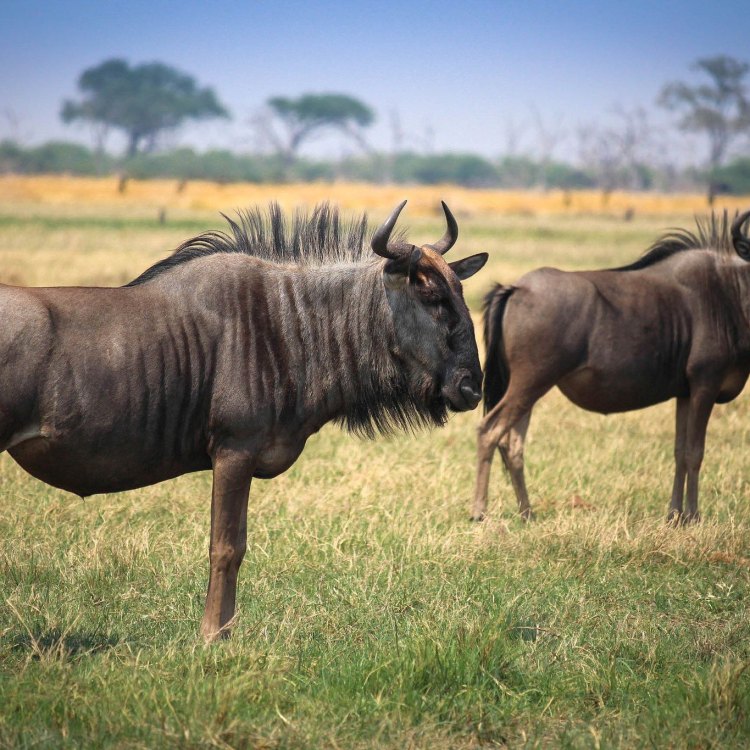
Connochaetes taurinus
The Magnificent Wildebeest: Thriving in the Wild and Captivating Hearts Worldwide
When you think of a wildebeest, you may picture a stampeding herd of animals, their distinctive curving horns glinting in the sun as they traverse the plains of Africa. These majestic creatures, also known as gnus, are an integral part of the African savanna ecosystem, playing a crucial role in maintaining its delicate balance. From their unique appearance to their incredible migrations and social behavior, wildebeests are truly fascinating creatures deserving of our attention and conservation efforts.The Basics: Size, Lifespan, and Reproduction
Standing at 1 PeaceOfAnimals.Com.3 to 1.5 meters (4.3 to 4.9 feet) at the shoulder, wildebeests are not the tallest animals in the African savanna. However, they are certainly not to be underestimated, as their muscular build and agility serve them well in their grassland and woodland habitats. These polygamous animals can live up to 20 years in the wild, provided they are not threatened by human activities or predators, which we will delve into later.Reproduction is a crucial aspect of any species' survival, and for wildebeests, this is also a highly social affair. Although they are not monogamous, wildebeests form strong bonds with their mates, and mating occurs during the rainy season, typically in February and March. During this time, males will compete for the attention and rights to mate with the females, and their loud grunts and snorts can be heard echoing across the savanna Worm.
A Journey Across the Savanna: Migration Patterns and Social Behavior
One of the most incredible aspects of wildebeests is their highly migratory nature. Every year, millions of these animals embark on an arduous journey, covering over 1,800 miles, in search of fresh grazing pastures and water sources. This is known as the Great Wildebeest Migration, a natural phenomenon that surpasses all other wildlife migrations in the world.This migration is divided into two halves, with the majority of wildebeests traveling from Tanzania's Serengeti National Park to Kenya's Masai Mara Reserve, and the rest making the journey back. This incredible undertaking is not only awe-inspiring, but it also serves a vital purpose in the ecosystem. As grazers, wildebeests play a crucial role in maintaining the grassland's balance by consuming excessive plant growth, allowing for new growth and preventing wildfires. They also aid in nutrient cycling by spreading fertilizer through their droppings, creating a healthier and more diverse ecosystem.
While on their journey, wildebeests form large herds, sometimes consisting of hundreds of thousands of individuals. These herds are highly social, and they have a complex communication system to maintain order and safety within the group. Interestingly, wildebeests are known to form symbiotic relationships with other animals, such as zebras and gazelles, providing mutual protection against predators.
Threats and Conservation Status
The wildebeest population is currently classified as "Least Concern" by the International Union for Conservation of Nature (IUCN). However, this does not mean that they are not facing threats. Habitat loss due to human activities such as agriculture, mining, and urbanization is a significant concern for the wildebeest population. This is particularly evident in the southern Serengeti, where their migration route has been disrupted, leading to a decline in their numbers.Hunting and poaching also pose a threat to wildebeests, as they are often targeted for their meat and hides. This is particularly prevalent in areas where they coexist with human settlements. Additionally, wildebeests are also threatened by predators such as lions, hyenas, and crocodiles. However, they have evolved to have a strong sense of hearing and smell, along with their agility, to avoid these predators and ensure their survival.
The Impact of Wildebeests on the Ecosystem
As we mentioned earlier, wildebeests are vital to the health and balance of the African savanna ecosystem. As grazers, they play a crucial role in controlling plant growth, maintaining soil fertility, and preventing wildfires. Their droppings also aid in fertilization, allowing for plant diversity and healthier vegetation. Additionally, wildebeests are a food source for predators, keeping their populations in check and ensuring a balanced food chain.Human Use: Tourism and Hunting
Wildebeests have long been a popular attraction for tourists visiting Africa's national parks and reserves. The Great Wildebeest Migration, in particular, is a major draw, with thousands of tourists visiting each year to witness this incredible natural phenomenon. Tourism has also played a significant role in sustaining the wildebeest population, as the revenue generated is often invested in conservation efforts and anti-poaching measures.Unfortunately, wildebeests are also a popular target for trophy hunting. This controversial practice has gained global attention, with many advocating for stricter regulations and bans on hunting wildebeests and other endangered species.
The Unique Features of the Wildebeest
Aside from their migration and social behavior, wildebeests have some distinctive features that make them stand out on the African savanna. The most notable of these features is their distinctive curving horns and broad muzzle. These unique horns are used for defense and also play a role in their mating rituals. Additionally, wildebeests are known for their high-pitched vocalizations, which can often be heard during their migration and mating season, adding to the savanna's symphony of sounds.Interesting Facts About the Wildebeest
- Contrary to popular belief, wildebeests are not dumb or foolish animals. They are exceptionally cautious and have been observed displaying strategic herd formation to avoid predators.- Wildebeests belong to the antelope family and are closely related to cows and goats.
- The Great Wildebeest Migration is known as one of the Seven Natural Wonders of Africa and is considered the "greatest wildlife show on earth."
- Wildebeests are excellent swimmers and will often cross rivers during their migration, even if it means facing the risk of being eaten by crocodiles.
In Conclusion
The wildebeest is a truly remarkable animal, displaying incredible adaptations and behaviors to survive in the harsh African savanna. Their annual migration, social behavior, and unique features make them a captivating species, drawing in tourists and researchers alike. However, as we continue to encroach upon their natural habitats and pose threats to their existence, it is crucial to acknowledge the vital role wildebeests play in maintaining the savanna's delicate balance. It is up to us to ensure that these magnificent creatures continue to thrive in the wild for generations to come.
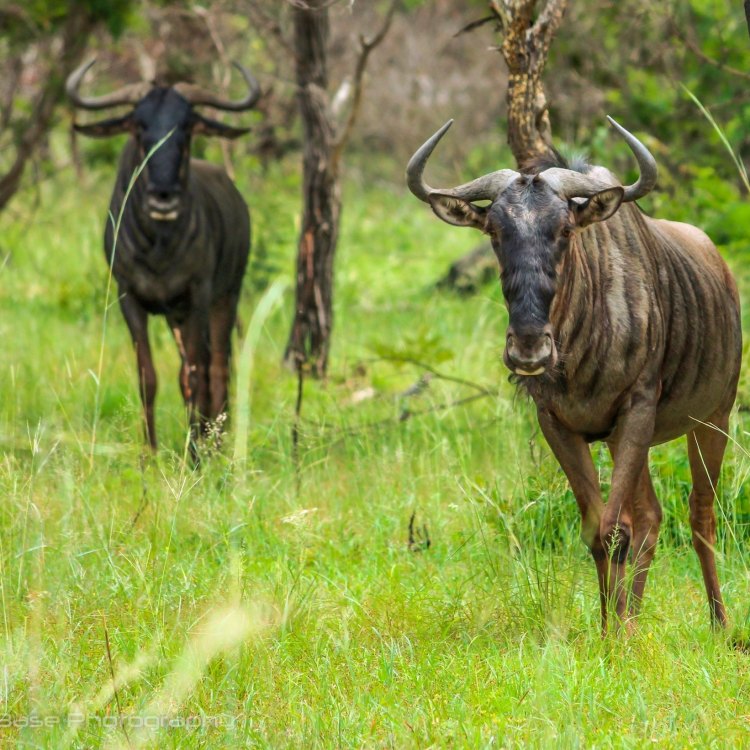
The Magnificent Wildebeest: A Marvel of the African Savanna
Disclaimer: The content provided is for informational purposes only. We cannot guarantee the accuracy of the information on this page 100%. All information provided here may change without prior notice.


